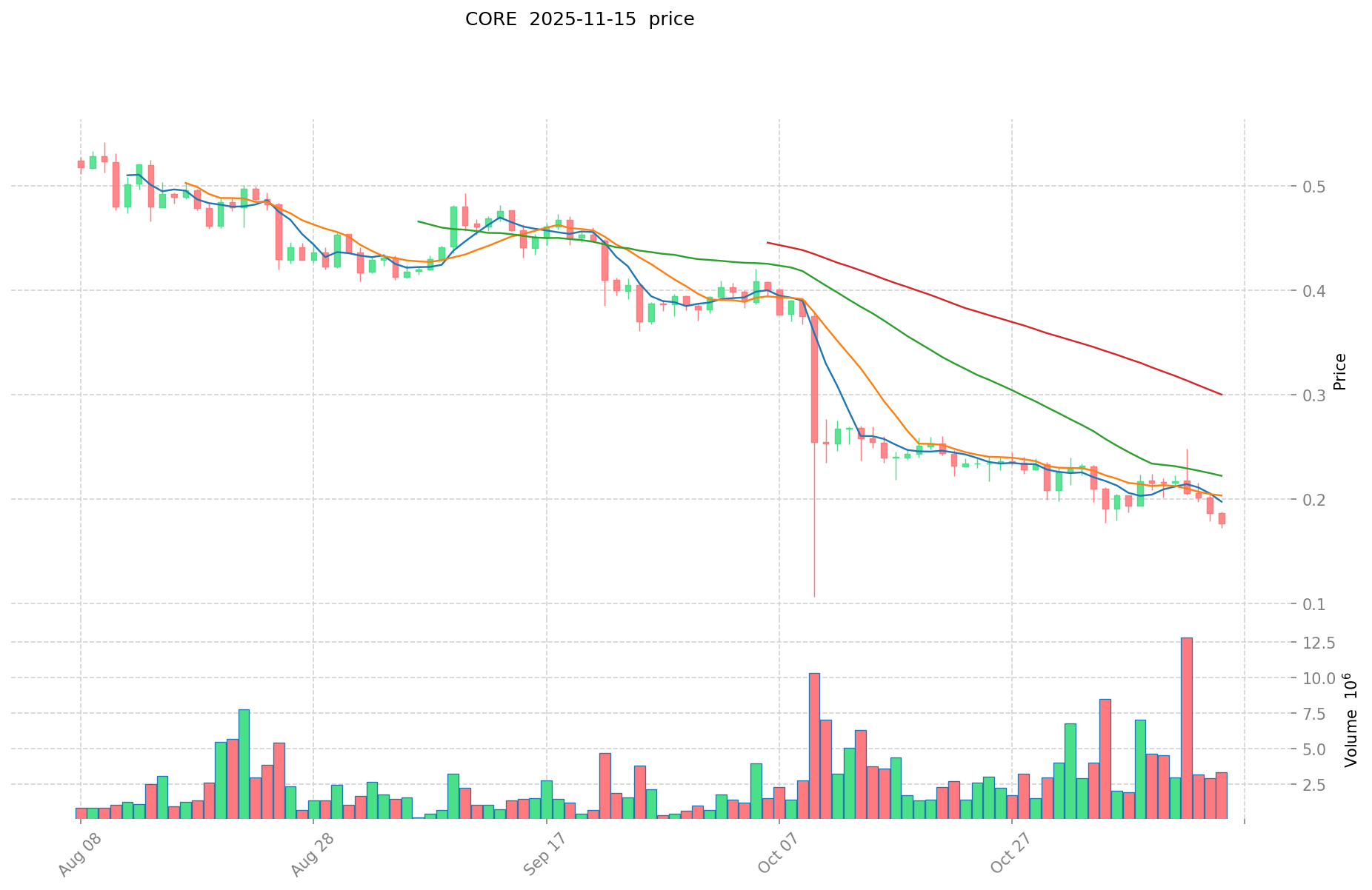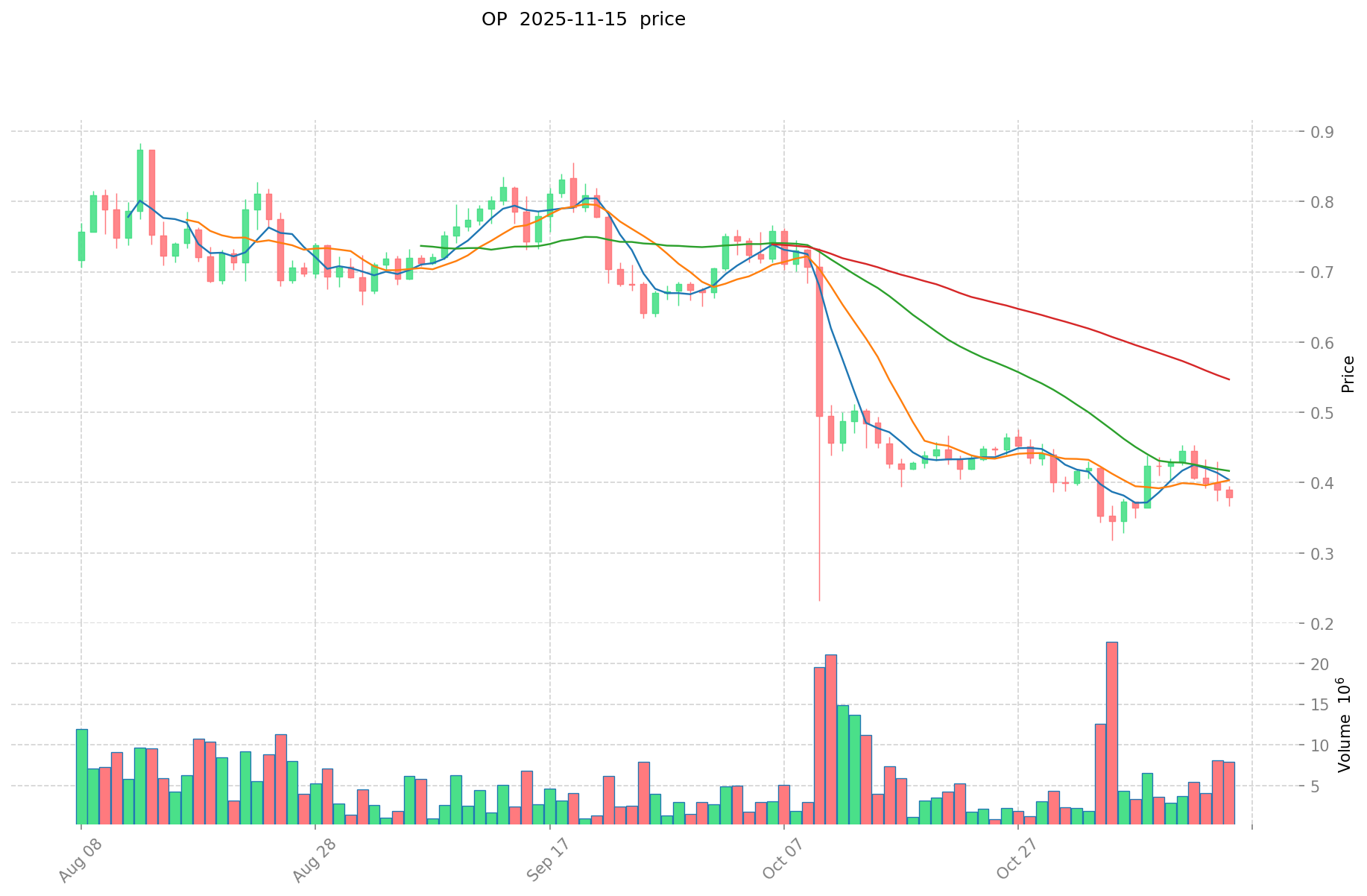CORE vs OP: Exploring the Differences Between Fundamental and Overpowered Game Mechanics
Introduction: Investment Comparison of CORE vs OP
In the cryptocurrency market, the comparison between Core DAO (CORE) vs Optimism (OP) has been an unavoidable topic for investors. The two not only show significant differences in market cap ranking, application scenarios, and price performance, but also represent different positions in crypto assets.
Core DAO (CORE): Since its launch, it has gained market recognition for its EVM-compatible L1 chain with a novel consensus mechanism called "Satoshi Plus".
Optimism (OP): Introduced as a low-cost, lightning-fast Ethereum Layer 2 blockchain, it has been addressing the practical needs of developers and users.
This article will provide a comprehensive analysis of the investment value comparison between CORE and OP, focusing on historical price trends, supply mechanisms, institutional adoption, technological ecosystems, and future predictions, attempting to answer the question that concerns investors the most:
"Which is the better buy right now?"
I. Price History Comparison and Current Market Status
CORE and OP Historical Price Trends
- 2023: CORE reached its all-time high of $6.14 on February 8, 2023.
- 2024: OP hit its all-time high of $4.84 on March 6, 2024.
- Comparative Analysis: In the recent market cycle, CORE dropped from its ATH of $6.14 to a low of $0.117272, while OP declined from $4.84 to $0.322746.
Current Market Situation (2025-11-16)
- CORE current price: $0.1783
- OP current price: $0.3914
- 24-hour trading volume: CORE $506,148 vs OP $1,263,758
- Market Sentiment Index (Fear & Greed Index): 10 (Extreme Fear)
Click to view real-time prices:
- Check CORE current price Market Price
- Check OP current price Market Price


II. Core Factors Influencing CORE vs OP Investment Value
Supply Mechanisms Comparison (Tokenomics)
-
CORE: Fixed maximum supply of 50 million tokens, with an annual inflation rate of 2% for sustainability; 42% of tokens are allocated to the community treasury
-
OP: Total supply of 4.29 billion tokens with gradual distribution; 25% allocated to ecosystem fund, 20% to retroactive public goods funding, and 19% to the community treasury
-
📌 Historical Pattern: Fixed supply models like CORE's tend to create supply-side pressure that supports value appreciation over time, while OP's larger supply with strategic distribution focuses on ecosystem growth and participation incentives.
Institutional Adoption and Market Applications
- Institutional Holdings: OP has secured investments from prominent venture capital firms including a16z, Paradigm, and Sequoia Capital, giving it stronger institutional backing
- Enterprise Adoption: CORE focuses on Ethereum L2 deployment with a unique faction system, while OP powers the Optimism network with established partnerships like Coinbase's Base
- Regulatory Attitudes: Both projects operate in the emerging L2 scaling solution space which faces evolving regulatory frameworks globally
Technical Development and Ecosystem Building
- CORE Technical Upgrades: Implemented secure decentralized sequencer systems and introduced innovative faction system for governance and network effect growth
- OP Technical Development: Pioneered optimistic rollups technology, developed the OP Stack, and established the Superchain vision for cross-chain interoperability
- Ecosystem Comparison: OP leads with wider adoption across major DeFi protocols, NFT marketplaces, and gaming applications with over 500 apps in its ecosystem; CORE is building a unique governance model with faction-based incentives but has a smaller ecosystem footprint
Macroeconomic Factors and Market Cycles
- Inflation Performance: Both tokens are primarily tied to Ethereum ecosystem growth rather than serving as inflation hedges
- Monetary Policy Impact: Both projects are susceptible to broader crypto market conditions influenced by central bank policies
- Geopolitical Factors: L2 solutions like CORE and OP benefit from growing global demand for efficient blockchain infrastructure, especially as Ethereum scales
III. Price Prediction for 2025-2030: CORE vs OP
Short-term Prediction (2025)
- CORE: Conservative $0.166098 - $0.1786 | Optimistic $0.1786 - $0.246468
- OP: Conservative $0.21593 - $0.3926 | Optimistic $0.3926 - $0.561418
Mid-term Prediction (2027)
- CORE may enter a growth phase, with projected prices $0.1309634508 - $0.3324456828
- OP may enter a stable growth phase, with projected prices $0.4939428195 - $0.6187283739
- Key drivers: Institutional capital inflow, ETFs, ecosystem development
Long-term Prediction (2030)
- CORE: Base scenario $0.31750779011952 - $0.365133958637448 | Optimistic scenario $0.365133958637448+
- OP: Base scenario $0.73170817497414 - $1.031708526713537 | Optimistic scenario $1.031708526713537+
Disclaimer: These predictions are based on historical data and current market trends. Cryptocurrency markets are highly volatile and subject to rapid changes. This information should not be considered as financial advice. Always conduct your own research before making investment decisions.
CORE:
| 年份 | 预测最高价 | 预测平均价格 | 预测最低价 | 涨跌幅 |
|---|---|---|---|---|
| 2025 | 0.246468 | 0.1786 | 0.166098 | 0 |
| 2026 | 0.29117158 | 0.212534 | 0.14452312 | 19 |
| 2027 | 0.3324456828 | 0.25185279 | 0.1309634508 | 41 |
| 2028 | 0.318442667676 | 0.2921492364 | 0.227876404392 | 63 |
| 2029 | 0.32971962820104 | 0.305295952038 | 0.1984423688247 | 71 |
| 2030 | 0.365133958637448 | 0.31750779011952 | 0.180979440368126 | 78 |
OP:
| 年份 | 预测最高价 | 预测平均价格 | 预测最低价 | 涨跌幅 |
|---|---|---|---|---|
| 2025 | 0.561418 | 0.3926 | 0.21593 | 0 |
| 2026 | 0.56287062 | 0.477009 | 0.29097549 | 21 |
| 2027 | 0.6187283739 | 0.51993981 | 0.4939428195 | 32 |
| 2028 | 0.785681046891 | 0.56933409195 | 0.3700671597675 | 45 |
| 2029 | 0.78590878052778 | 0.6775075694205 | 0.5420060555364 | 72 |
| 2030 | 1.031708526713537 | 0.73170817497414 | 0.475610313733191 | 86 |
IV. Investment Strategy Comparison: CORE vs OP
Long-term vs Short-term Investment Strategies
- CORE: Suitable for investors focused on unique governance models and potential L1 ecosystem growth
- OP: Suitable for investors interested in established L2 solutions and Ethereum scaling technologies
Risk Management and Asset Allocation
- Conservative investors: CORE: 30% vs OP: 70%
- Aggressive investors: CORE: 60% vs OP: 40%
- Hedging tools: Stablecoin allocation, options, cross-token portfolios
V. Potential Risk Comparison
Market Risks
- CORE: Higher volatility due to smaller market cap and less liquidity
- OP: Exposure to broader Ethereum ecosystem risks and L2 competition
Technical Risks
- CORE: Scalability, network stability, and adoption of the faction system
- OP: Reliance on Ethereum's development, potential vulnerabilities in optimistic rollup technology
Regulatory Risks
- Global regulatory policies may impact both differently, with OP potentially facing more scrutiny due to its larger ecosystem and institutional backing
VI. Conclusion: Which Is the Better Buy?
📌 Investment Value Summary:
- CORE advantages: Unique consensus mechanism, fixed supply model, potential for high growth
- OP advantages: Established ecosystem, strong institutional backing, proven L2 technology
✅ Investment Advice:
- New investors: Consider a balanced approach with a higher allocation to OP for its established ecosystem
- Experienced investors: Explore CORE for its growth potential while maintaining a significant position in OP
- Institutional investors: Focus on OP for its scalability and ecosystem integration, with a smaller allocation to CORE for diversification
⚠️ Risk Warning: The cryptocurrency market is highly volatile. This article does not constitute investment advice. None
VII. FAQ
Q1: What are the main differences between CORE and OP? A: CORE is an EVM-compatible L1 chain with a novel consensus mechanism called "Satoshi Plus", while OP is a Layer 2 scaling solution for Ethereum. CORE has a fixed maximum supply of 50 million tokens, while OP has a larger supply of 4.29 billion tokens with gradual distribution.
Q2: Which token has shown better price performance recently? A: In the recent market cycle, OP has shown better price performance. While CORE dropped from its ATH of $6.14 to $0.1783, OP declined from $4.84 to $0.3914, maintaining a higher current price.
Q3: How do the ecosystems of CORE and OP compare? A: OP leads with wider adoption across major DeFi protocols, NFT marketplaces, and gaming applications, with over 500 apps in its ecosystem. CORE is building a unique governance model with faction-based incentives but has a smaller ecosystem footprint.
Q4: What are the long-term price predictions for CORE and OP? A: By 2030, CORE's base scenario is predicted to be $0.31750779011952 - $0.365133958637448, while OP's base scenario is projected at $0.73170817497414 - $1.031708526713537.
Q5: How do institutional adoptions compare between CORE and OP? A: OP has secured investments from prominent venture capital firms including a16z, Paradigm, and Sequoia Capital, giving it stronger institutional backing compared to CORE.
Q6: What are the main risks associated with investing in CORE and OP? A: CORE faces higher volatility due to smaller market cap and less liquidity, while OP is exposed to broader Ethereum ecosystem risks and L2 competition. Both face potential regulatory risks, with OP potentially facing more scrutiny due to its larger ecosystem and institutional backing.
Q7: Which token is recommended for new investors? A: For new investors, a balanced approach with a higher allocation to OP is suggested due to its established ecosystem and stronger institutional backing.
Share
Content